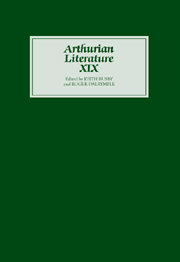Book contents
- Frontmatter
- Contents
- General Editor's Foreword
- I Comedy and Tragedy in Some Arthurian Recognition Scenes
- II Merveilleux et comique dans les romans arthuriens français (XIIe–XVe siècles)
- III La bande dessinée virtuelle du lion d'Yvain: sur le sens de l'humour de Chrétien de Troyes
- IV Convention, Comedy and the Form of La Vengeance Raguidel
- V Le comique dans Les Merveilles de Rigomer et Hunbaut
- VI Humour in the Roman de Silence
- VII La pratique de la ‘disconvenance’ comique dans le Lancelot en prose: les mésaventures amoureuses de Guerrehet
- VIII Lancelot Part 3
- IX Comic Functions of the Parrot as Minstrel in Le Chevalier du Papegau
- X Dinadan en Italie
- XI A Comical Villain: Arthur's Seneschal in a Section of the Middle Dutch Lancelot Compilation
- XII Malory and the English Comic Tradition
- XIII ‘Laughyng and Smylyng’: Comic Modalities in Malory's Tale of Sir Launcelot du Lake
- XIV The Eachtra an Amadáin Mhóir as a Response to the Perceval of Chrétien de Troyes
- CONTENTS OF PREVIOUS VOLUMES
IV - Convention, Comedy and the Form of La Vengeance Raguidel
Published online by Cambridge University Press: 05 February 2013
- Frontmatter
- Contents
- General Editor's Foreword
- I Comedy and Tragedy in Some Arthurian Recognition Scenes
- II Merveilleux et comique dans les romans arthuriens français (XIIe–XVe siècles)
- III La bande dessinée virtuelle du lion d'Yvain: sur le sens de l'humour de Chrétien de Troyes
- IV Convention, Comedy and the Form of La Vengeance Raguidel
- V Le comique dans Les Merveilles de Rigomer et Hunbaut
- VI Humour in the Roman de Silence
- VII La pratique de la ‘disconvenance’ comique dans le Lancelot en prose: les mésaventures amoureuses de Guerrehet
- VIII Lancelot Part 3
- IX Comic Functions of the Parrot as Minstrel in Le Chevalier du Papegau
- X Dinadan en Italie
- XI A Comical Villain: Arthur's Seneschal in a Section of the Middle Dutch Lancelot Compilation
- XII Malory and the English Comic Tradition
- XIII ‘Laughyng and Smylyng’: Comic Modalities in Malory's Tale of Sir Launcelot du Lake
- XIV The Eachtra an Amadáin Mhóir as a Response to the Perceval of Chrétien de Troyes
- CONTENTS OF PREVIOUS VOLUMES
Summary
La Vengeance Raguidel, by Raoul, is doubtless remembered best – by readers who know it at all – for its inclusion of a fabliau-like scene that, as Beate Schmolke-Hasselmann points out, ‘is generally regarded as the most improper in the whole of French Arthurian literature.’ That the romance is otherwise not widely known may be due in part to dismissive judgments from past generations of scholars. Micha, for example, suggested that it lacks unity,3 and long before that Bruce had found it a ‘rambling’ composition, inferior in interest to Meraugis de Portlesguez – no mild criticism since he considered Meraugis poorly constructed, extravagant, and often insipid.
Fortunately arrayed against these condemnations are the views of a number of more recent scholars (e.g., Schmolke-Hasselmann, Busby, Pallemans, Thompson, and others5) who have praised La Vengeance Raguidel as a fascinating study of Gauvain and/or as an appealing parody of romance themes and motifs. In fact, the composition is distinguished by the author's unremitting manipulation of familiar Arthurian motifs, which he regularly transforms in novel ways, often for humorous effect. The most innovative of these changes occurs near the midpoint of the text, when the character of the protagonist, Gauvain, is abruptly inverted and he becomes everything that experienced readers of French Arthurian romance expect him not to be.
- Type
- Chapter
- Information
- Arthurian Literature XIXComedy in Arthurian Literature, pp. 65 - 76Publisher: Boydell & BrewerPrint publication year: 2002

